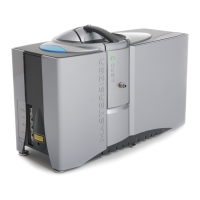Maintenanc e
85
Gritty surface particles/smeared surface — with grit
If the surface has fingerprints on it or has not been cleaned for a long time, assume there
is grit present. First wash the surface then wipe it as described; refer to the Washing cell
windows and Wiping cell window sections below.
Dusty surface
If the surface is just dusty use a clean air aerosol duster or soft brush; refer to the “Clean
air” aerosol dusters and Brushing optical surfaces sections below. If marks are still present
after this, wipe the surface as described in the Wiping cell window section below.
Smeared surface — no grit
If the surface is smeared and you are sure there is no grit on it, wipe the surface as
described below in the Wiping cell window section below.
Caution!
The outer faces of the windows have an anti-reflective coating and are more
prone to scratches than the inner surfaces. Be careful not to touch the faces of
the windows or put them down on dirty surfaces.
Washing cell windows
Wash the cell windows if there are particles deposited on the surface.
Requirements
l Neutral detergent, such as Decon 75 (most detergents used to clean glassware
can be used if sufficiently dilute)
l Soft brush, such as sable
l Petri dish
l Ethanol bottlewash

